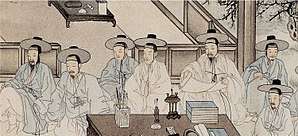Korean folklore
 |
| Part of a series on the |
| Culture of Korea |
|---|
| History |
|
Music and performing arts |
|
|
Monuments |
|
National symbols of Korea |
|
Korean folklore is well established, going back several thousand years. The folklore's basis derives from a variety of belief systems, including Shamanism, Confucianism, Buddhism and more recently Christianity.[1] Mythical creatures often abound in the tales, including the Korean conception of goblins.
Types of Folklore
There are many types of folklore in Korean culture, including Imuldan (이물담), focused on supernatural beings such as monsters, goblins and ghosts. The most common of which are the Dokkaebi (도깨비), meaning goblin. However, this term differs from the European concept of 'goblin' in that they do not possess a evil or demonic characteristic. Instead, they are creatures with powers that seek to both bring delight to people and misery. These beings engage either in friendly or annoying behavior with humans. Their interactions with humans represent the belief in the supernatural and their interactions with humanity. The presence of these beings is meant to represent both difficulties and pleasures in life.
Contemporary Revival
A revival on internet sites occurred recently, providing inspiration for artists and illustrators.
Recent achievements in keeping Korean folklore alive include the 150-part animated TV series, "Animentary Korean Folklore", telling old tales with a traditional 2-D Korean styled animation.
External Links
See also
- ↑ "Korean Folklore – Goblins and Other Beings". Sageuk: Korean Historical Dramas. 2016-12-16. Retrieved 2018-10-12.